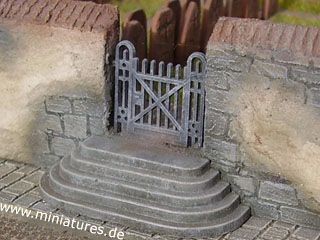Concrete Steps
Faller 1:87 Scale Scenery Review

Cemetary wall with steps and metal gate from Faller. The steps are the same height as the 10 mm styrofoam board used to raise the ground level inside the cemetary. The raised level looks good, and it provides enough depth to show open graves. The surrounding walls are made of 5 mm foamcore, and the stones have been engraved in a thin coating of interior filler. Patches of plastering are in the original offwhite tone of the filler, but the edges have been weathered in a much dirtier colour. The tiles on the top of the wall were shaped by pressing a thick needle into the fresh filler at regular intervals. The detailed parts made by Faller draw the viewers attention, and they significantly reduce construction time.
Contents
51 Parts in 2 Colours
- Period II, after 1921
- 7 Concrete Steps (one-piece castings)
- 120 cm of Stairs, three Widths
- 10 Landings, three Widths
- 240 cm of Handrails
- 1:72 Scale Height per Step: 14 cm
- 1:72 Scale Width: 86, 130 & 346 cm
Evaluation
Valuable accessories for little money. The stairs cost only $US 0.10 per centimeter, they are cheap and convenient parts for scratchbuilding.
Scale Model. In 1:72 scale, the stairs do not conform exactly to DIN standards, but the difference is hardly noticeable.
Construction is easy. The stairs are supplied in length of 215 mm and 90 mm, they only need to be cut to fit. The landings have a bevelled edge which helps set the angle of the stairs correctly. This edge cannot be undercut in the mould, which is why we find circular ejector pin marks on the visible side of the landing. Some filling and sanding is required.
Good quality. Mould lines are hidden on the sides of the castings, and there is no flash on the stairs. The handrails are easily scraped clean of flash, using a scalpel blade, but there are many sprue lugs which need to be trimmed and sanded.
The stairs are in a medium grey plastic, handrails are dark grey. Painting is not strictly required, but weathering is a must. The edges of the steps may be chipped with a knife and rounded with sandpaper to show some wear and tear.
The one-piece castings of the concrete steps are particularly useful for representative buildings and entrances to parks. Four different types are included in the set, one L-shape and three halved ovals. Each piece is has five steps, and it can be mounted flush against a 10 mm playwood or styrofoam board. The L-shaped piece comes with small lamps at the corners.
The steps represent concrete castings, unsuitable for early periods of history. Conversion to stone steps involves carving individual stone blocks into the plastic material, using a scalpel or engraving tool. Steps made from sandstone should be eroded with sandpaper to show the effect of people walking on them.
Historical Employment
- Building entrances, steps in villages and parks, after 1921
These steps are ideal for scratchbuilders who want to save time and achieve accurate results. The different types of steps in this kit inspire modellers to take on a variety of construction projects, including government buildings, villas, courtyards, and parks. In addition to these parts, we would like to see historic windows, shutters, doors, mouldings and other small parts which could be used to customize a plastered wall section. Plastic or plaster parts only need to pressed into fresh filler to be attached permanently.